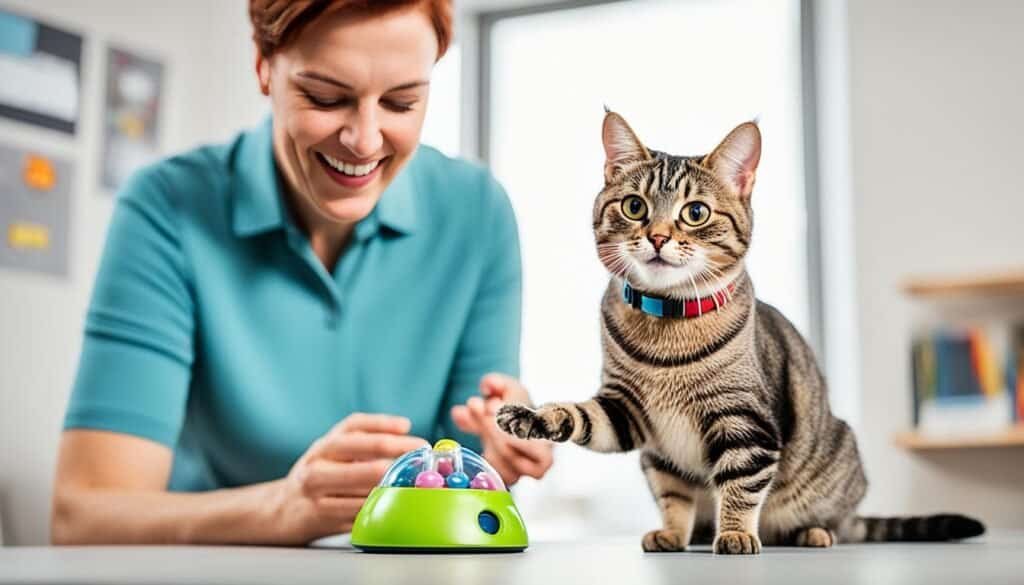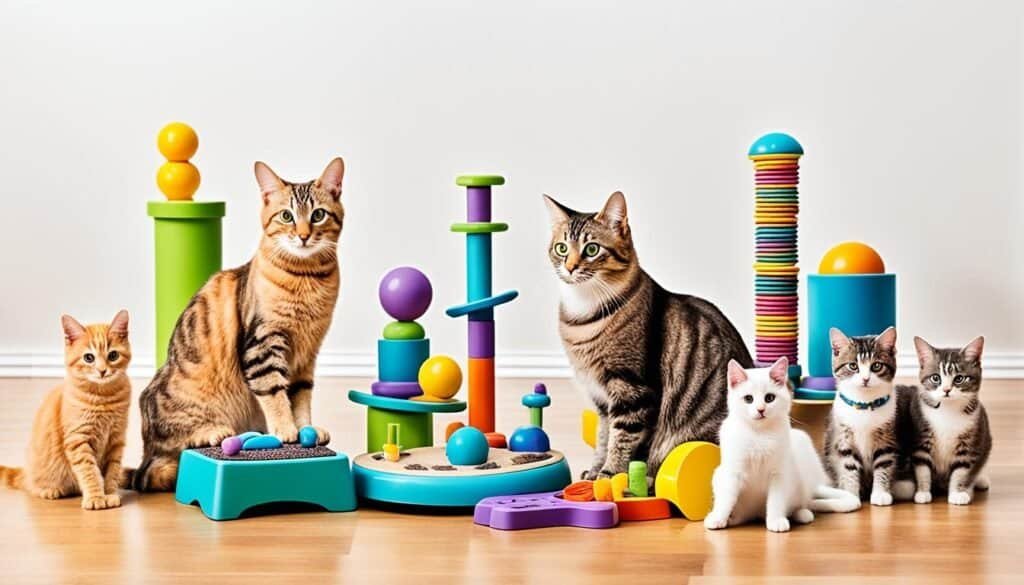Welcome to our guide on cat socialization techniques! If you’re a cat owner looking to improve your furry friend’s social skills, this article is for you. We’ll dive into tips for cat socialization, effective cat bonding methods, and strategies for introducing cats to other animals. Whether you have a shy or outgoing cat, we have you covered with cat behavior modification strategies and feline socialization training. So let’s begin the journey of building trust with your beloved feline and creating a harmonious environment for all. But before we proceed, let’s take a look at why socialization is crucial for cats.
Key Takeaways:
- Learn tips for cat socialization to help your furry friend become confident and comfortable with others.
- Explore effective cat bonding methods to strengthen the bond between you and your cat.
- Discover strategies for socializing cats with other animals, such as dogs and other cats.
- Gain insights into cat behavior modification strategies and feline socialization training.
- Understand the importance of building trust with shy or fearful cats and learn techniques for overcoming socialization challenges.
Understanding the Importance of Socialization
Before delving into the various Cat Socialization Techniques, it’s crucial to recognize the significance of socialization for cats. Socialization is a process that involves introducing cats to different people, animals, and environments in order to develop their ability to interact and adapt. Building trust with your cat is a fundamental aspect of this process, laying the foundation for a happier and healthier feline companion.
Socialization plays a vital role in a cat’s overall well-being. By exposing them to diverse experiences, you can help prevent behavioral issues such as aggression, anxiety, and fear. Socialized cats tend to be more confident, adaptable, and resilient in their everyday lives.
The Benefits of Socialization
- Reduced Stress: Socialization helps cats become familiar with various situations, reducing stress levels and promoting a sense of security.
- Enhanced Bonding: Building trust with your cat through socialization creates a stronger bond between you and your feline friend, enhancing your relationship.
- Improved Confidence: Socialized cats gain confidence in navigating new environments, meeting new people, and interacting with other animals.
- Prevention of Problematic Behaviors: Socialization can prevent aggressive behavior, litter box issues, and other behavioral problems commonly associated with unsocialized cats.
- Adaptability: Cats that are well-socialized are better equipped to handle changes in their environment, such as moving to a new home or encountering unfamiliar situations.
Socialization is a lifelong process that should start early in a cat’s life, but it can also be introduced to older cats. Stay tuned to discover effective techniques and strategies for building trust with your cat and successfully socializing them with other animals, ensuring a positive and enriching experience for both you and your feline companion.
Early Socialization for Kittens
Kittens are most receptive to socialization during their early weeks. This crucial period sets the foundation for their future behavior and interactions with others. By implementing effective cat bonding methods and cat behavior modification strategies, you can create a confident and well-adjusted cat.
1. Gradual Exposure to New Experiences
Expose your kitten to various stimuli in a controlled and positive manner. Introduce them to different sounds, textures, and environments to help them develop resilience and adaptability. Start with gentle introductions and gradually increase the level of exposure.
2. Positive Reinforcement
Use positive reinforcement techniques such as treats, praise, and play to reward your kitten’s desired behaviors. This approach helps them associate positive experiences with social interactions, encouraging them to seek out socialization opportunities.
3. Encourage Gentle Handling and Touch
Regularly handle your kitten gently and provide positive touch experiences. Start with short sessions and gradually increase the duration. This helps them become comfortable with human touch, making interactions with people more enjoyable.
4. Socializing with Other Kittens
Arrange playdates with other well-socialized kittens to encourage healthy social interactions. This allows your kitten to learn appropriate play behavior and communication skills.
5. Controlled Introductions to Friendly Cats
When your kitten is ready, carefully introduce them to friendly and well-behaved adult cats. Start with supervised short interactions and gradually increase the duration. This helps them develop positive relationships with other cats.
- Always monitor interactions to ensure they remain safe and positive.
- If any aggressive or fearful behavior is observed, separate the cats and consult a professional for guidance.
By implementing these early socialization techniques, you can help your kitten grow into a confident and socially adept feline companion.
Introduction to Other Animals
Many cat owners have multiple pets at home and strive for a harmonious living environment. Socializing cats with other animals, such as dogs and other cats, is an important aspect of cat socialization techniques. By introducing cats to different animals properly, you can foster positive relationships and ensure peaceful coexistence.
1. Socializing Cats with Dogs
Socializing cats with dogs requires gradual introductions to build trust and familiarity. Start by keeping them in separate rooms initially, allowing both animals to become accustomed to each other’s scent. Then, gradually introduce visual contact by using a baby gate or a pet screen door. This allows them to see and observe each other without direct physical interaction.
Next, you can create controlled interactions by using leashes or harnesses. Keep the initial meetings short and supervise closely to prevent any aggressive behavior. Gradually increase the duration and frequency of these interactions as both animals become more comfortable. Positive reinforcement, such as treats and praise, can also be used to reward calm and friendly behavior.
2. Introducing Cats to Other Cats
Socializing cats with other cats requires a slow and gradual approach. Start by keeping the new cat in a separate room, equipped with all the essentials like food, water, litter box, and a comfortable bed. This allows the resident cat to explore the new cat’s scent and become familiar with their presence.
Once the cats appear comfortable with each other’s scent, you can start with supervised visual introductions. Use a baby gate or, for more cautious cats, a cracked door, to allow them to see each other without direct physical contact. This helps them get accustomed to each other’s presence in a controlled manner.
Gradually progress to brief, supervised physical introductions. Ensure that both cats have an escape route and provide plenty of hiding places, scratching posts, and vertical spaces to reduce tension. It’s important not to force interactions and allow the cats to set the pace. Over time, they will establish their own dynamic and develop a bond.
Remember, every cat is unique, and the process of socialization may vary. Patience, consistency, and gradual introductions are key to successful socialization with other animals.
- Gradual introductions are crucial for socializing cats with other animals, such as dogs and other cats.
- Start with separate rooms and gradually introduce visual contact using barriers like baby gates.
- For dogs, use leashed introductions and reward calm and friendly behavior.
- For cats, start with separate rooms and progress to supervised visual and physical introductions.
- Provide hiding places and vertical spaces to reduce tension and allow the cats to establish their own dynamic.
Building Trust with Shy or Fearful Cats
Some cats may be shy or fearful, which can make socialization challenging. However, with the right strategies and techniques, you can help your cat build trust and become more comfortable in social situations. By taking a patient and understanding approach, you can gradually help your feline friend overcome their fears and develop positive associations with people and other animals.
One effective method for building trust with shy or fearful cats is through positive reinforcement. This involves rewarding your cat with treats, praise, or play whenever they exhibit calm and confident behavior. By associating positive experiences with social interactions, your cat will gradually learn to trust and feel more at ease.
Another helpful technique is gradual exposure. Start by creating a safe and secure environment for your cat, providing them with hiding places and vertical spaces. Allow your cat to approach and interact with new people or animals at their own pace, without any forced interactions. Gradually increase the level of exposure over time, always prioritizing your cat’s comfort and well-being.
Additional strategies to build trust with shy or fearful cats include:
- Creating a calm and predictable routine to help your cat feel more secure
- Using pheromone sprays or diffusers to create a soothing environment
- Providing plenty of hiding spots and elevated perches for your cat to retreat to
- Using interactive toys and games to help your cat build confidence and trust
- Introducing a new cat companion gradually and under controlled circumstances
- Seeking the assistance of a professional animal behaviorist if needed
Remember, building trust with shy or fearful cats takes time and patience. Every cat is unique, so it’s important to tailor your approach to their individual needs and personality. By providing a supportive environment and using positive reinforcement, you can help your cat overcome their fears and develop strong bonds with you and others.
Introducing New Cats to Each Other
When adding a new cat to your household, it is crucial to approach the introduction process with care and consideration. Cats are territorial creatures, and introducing a new feline companion can be stressful for both the existing cat and the newcomer. By following these step-by-step guidelines, you can minimize stress and promote positive interactions between your cats.
1. Prepare a Separate Space
Before the initial introduction, create a separate space for the new cat. This space should include all the necessary essentials such as a litter box, food, water, and comfortable resting areas. This will help the new cat feel secure and prevent any territorial disputes during the early stages of the introduction.
2. Scent Exchange
Start by exchanging scents between the cats to familiarize them with each other’s presence. You can do this by using separate bedding or rubbing a cloth on each cat and then exchanging the cloths so that they can sniff and become accustomed to the scent of the other cat. This will help reduce anxiety and create a sense of familiarity.
3. Controlled Visual Introduction
Once the cats are comfortable with each other’s scents, you can proceed to a controlled visual introduction. Place a baby gate or screen door between the two cats, allowing them to see each other without physical contact. Monitor their behavior during this time, looking for signs of aggression or excessive stress.
4. Gradual Physical Interaction
If the visual introduction goes well, you can progress to supervised physical interactions. Start with short sessions in a neutral area where neither cat feels territorial. Use treats and positive reinforcement to reward calm behavior. Gradually increase the duration of these interactions over time.
5. Separate Feeding Areas
During the initial stages of introducing new cats, it’s essential to provide separate feeding areas. This helps prevent competition and territorial disputes over resources such as food. Slowly move the feeding areas closer together as the cats become more comfortable in each other’s presence.
6. Patience and Persistence
Remember that the process of introducing new cats can take time. Each cat is unique, and their individual personalities will influence the speed at which they adapt to each other. Be patient and persistent, allowing your cats to set the pace and gradually build their own relationship.
By following these steps and providing a supportive environment for your cats, you can increase the chances of a successful introduction and foster a harmonious relationship between your feline companions.
The Role of Environment in Socialization
When it comes to cat socialization, the environment plays a crucial role in shaping their behavior and overall well-being. Feline socialization training involves creating a cat-friendly environment that helps your furry friend feel safe, secure, and comfortable.
A cat-friendly environment encompasses several key factors that contribute to successful socialization. Here are some important considerations:
- Provide a designated safe space: Cats, especially when first introduced to a new environment, need a safe and quiet space where they can retreat when feeling overwhelmed or anxious. This space should be equipped with a cozy bed, litter box, and water and food bowls.
- Offer hiding spots: Make sure to provide hiding spots throughout your home, such as cat trees, cardboard boxes, or soft blankets. These hiding spots allow your cat to observe their surroundings while feeling protected.
- Ensure vertical spaces: Cats are natural climbers and enjoy being in high places. Install shelves, provide cat trees, or create window perches that allow your cat to climb and survey their territory.
- Enrichment activities: Engage your cat in playful and mentally stimulating activities to keep them entertained. Use interactive toys, puzzle feeders, and scratching posts to provide both physical and mental stimulation.
A cat-friendly environment, combined with effective cat socialization techniques, plays a significant role in helping your cat feel comfortable and confident socializing with both humans and other animals. By providing the right environment, you are setting the stage for successful socialization.
Positive Reinforcement and Training Techniques
Positive reinforcement and training are powerful tools for cat socialization and behavior modification. By using effective techniques, you can encourage positive behaviors and foster better social interactions. Here, we will explore different training methods that can help you shape your cat’s behavior and promote positive socialization.
1. Clicker Training
Clicker training is a popular and effective method for teaching cats new behaviors. This technique involves using a clicker to mark desirable behaviors, followed by rewarding the cat with a treat. The sound of the clicker acts as a clear signal to the cat, helping them associate the behavior with the reward. Over time, the cat learns to repeat the desired behavior to earn the reward.
2. Target Training
Target training involves teaching your cat to touch a specific object, such as a target stick or your hand, with their nose or paw. This technique helps redirect their attention and encourages them to engage in desired behaviors. By gradually shaping their behavior through rewards, you can train your cat to perform various actions, such as following the target or jumping on a specific spot.
3. Desensitization and Counterconditioning
Desensitization and counterconditioning are effective techniques for modifying fear or aggression-related behaviors in cats. They involve gradually exposing the cat to the triggering stimulus or situation and associating it with positive experiences. For example, if your cat is afraid of loud noises, you can gradually expose them to low-level sounds while rewarding them with treats or playtime. Over time, the cat learns to associate the previously fear-inducing trigger with positive feelings.
4. Environmental Enrichment
Creating a stimulating and enriching environment can help alleviate unwanted behaviors and promote socialization. Provide plenty of toys, scratching posts, and perches to keep your cat mentally and physically engaged. Rotating toys and incorporating interactive play sessions also help prevent boredom and encourage positive interactions with both humans and other animals.

5. Consistency and Patience
Consistency and patience are key when training your cat. Establish clear rules and boundaries and provide regular training sessions to reinforce desired behaviors. Be patient and understanding, as cats may take time to adjust and learn new behaviors. Remember to reward your cat immediately after they exhibit the desired behavior to reinforce the connection between the behavior and the reward.
By utilizing these positive reinforcement and training techniques, you can effectively modify your cat’s behavior and enhance their socialization skills. Remember, each cat is unique, so experiment with different methods to find what works best for your feline companion.
Socialization Challenges and Troubleshooting
Socializing cats can sometimes present challenges. However, with patience and the right techniques, you can overcome these hurdles and help your feline friend become comfortable around others. In this section, we will address common issues and provide troubleshooting tips to navigate the socialization process.
1. Aggression Towards Other Cats
If your cat displays aggression towards other cats during the socialization process, it’s crucial to address this behavior promptly. Here are some tips to manage and reduce aggression:
- Gradual Introductions: Allow cats to become familiar with each other’s scents and gradually introduce them in controlled environments.
- Positive Reinforcement: Reward calm and non-aggressive behavior with treats and praise, redirecting focus away from aggression.
- Separate Feeding Areas: Provide separate feeding areas for each cat to avoid potential conflicts over food.
2. Fear or Timidity
If your cat is shy or fearful, it’s important to create a safe and secure environment for them to build confidence. Consider the following strategies:
- Quiet Space: Provide a quiet area where your cat can retreat to when feeling overwhelmed.
- Slow Approach: Let your cat approach you on their terms, avoiding any sudden movements or loud noises that may frighten them.
- Positive Reinforcement: Use treats and gentle praise to reward your cat for coming out of their shell and engaging in social interactions.
3. House Soiling
House soiling can be a common issue during the socialization process. To address this problem, consider the following strategies:
- Litter Box Placement: Ensure that litter boxes are easily accessible and placed in quiet areas away from high foot traffic.
- Cleanliness: Regularly clean litter boxes to maintain cleanliness and reduce odors.
- Pheromone Diffusers: Consider using pheromone diffusers, such as Feliway, to help alleviate stress-related behaviors.
4. Excessive Hiding
If your cat tends to hide excessively during socialization, try the following tips to encourage them to come out of their hiding spot:
- Hiding Places: Provide alternative hiding spots, such as cat trees or enclosed beds, that offer a sense of security while allowing your cat to observe their surroundings.
- Scent Swap: Gently rub a cloth on your cat’s face to collect their scent and then place it near their hiding spot. This can help them become familiar with their own scent in the environment.
- Patience: Give your cat time to adjust and feel comfortable exploring their surroundings at their own pace.
Remember, every cat is unique, and the socialization process may vary. Be patient, consistent, and observant of your cat’s body language. With time and effort, you can help your cat overcome socialization challenges and create a harmonious environment where they can thrive.
Providing Enrichment and Stimulation
Enrichment and stimulation are crucial elements in the socialization of cats. By providing mental and physical stimulation, you can strengthen the bond between you and your feline friend. Here are some tips for effective cat socialization and bonding:
- Interactive Play: Engage in interactive play sessions with your cat using toys such as wand toys, laser pointers, or treat-dispensing puzzles. This not only provides physical exercise but also stimulates their hunting instincts.
- Environmental Enrichment: Create a stimulating environment for your cat by offering a variety of toys, scratching posts, and climbing structures. Incorporate hiding spots and perches to allow them to observe their surroundings and feel secure.
- Scent Exchange: Introduce your cat to different scents by rubbing towels or blankets on yourself and other animals in the house. This helps familiarize them with the scent and promotes positive associations.
- Clicker Training: Use positive reinforcement training techniques, such as clicker training, to teach your cat new behaviors and tricks. This not only provides mental stimulation but also strengthens the bond between you and your cat.
- Puzzle Feeders: Incorporate puzzle feeders into your cat’s feeding routine to engage their problem-solving skills and provide mental stimulation. This can help keep them entertained and prevent boredom.
Image:

Remember, each cat is unique, so pay attention to their individual preferences and adjust the enrichment activities accordingly. Providing daily enrichment and stimulation will not only make your cat happier but also strengthen the bond you share with them.
Socialization and Adopted Cats
When it comes to adopting a cat, socialization plays a significant role in helping them adjust to their new environment. Adopted cats may have had difficult experiences in the past, making it essential to approach their socialization process with care and patience. In this section, we will provide tips specifically tailored for socializing and building trust with adopted cats.
1. Creating a Safe Space: Set up a designated area in your home where your newly adopted cat can feel secure. Provide them with a comfortable bed, toys, and a litter box in this space to help establish trust and a sense of security.
2. Slow and Gentle Introduction: Gradually introduce your adopted cat to different parts of your home and other family members. Be patient and allow them to explore at their own pace, ensuring they feel safe and supported throughout the process.
3. Positive Reinforcement: Use treats, praise, and gentle petting to reward your cat for positive behaviors. This positive reinforcement will help them associate good experiences with social interactions, building trust and confidence over time.
4. Quiet and Calm Environment: Avoid overwhelming your adopted cat with loud noises or sudden movements, as this can cause stress and anxiety. Create a calm and peaceful environment to help them feel more at ease and encourage their socialization process.
5. Gradual Exposure to New Experiences: Introduce your adopted cat to new experiences, such as meeting other pets or encountering new people, in a controlled and gradual manner. This exposure will help them develop positive associations and confidence in social situations.
6. Consulting a Professional: If you encounter challenges in socializing your adopted cat, consider seeking advice from a professional animal behaviorist or your veterinarian. They can provide tailored guidance and support based on your cat’s specific needs.
Conclusion
In conclusion, cat socialization is a vital aspect of their overall well-being. By implementing effective techniques, building trust, and providing a supportive environment, you can help your cat become confident and comfortable with others. Use the tips and strategies mentioned throughout this article to ensure a positive socialization experience for your feline companion.
FAQ
What are some tips for cat socialization?
Why is cat socialization techniques important?
How can I socialize my cat with other animals?
How can I build trust with a shy or fearful cat?
What is the best way to introduce new cats to each other?
How does the environment impact cat socialization?
What are some effective cat behavior modification strategies?
What should I do if I encounter socialization challenges?
How can I provide enrichment and stimulation for my cat?
How should I approach socializing adopted cats?
Last modified: March 11, 2024













